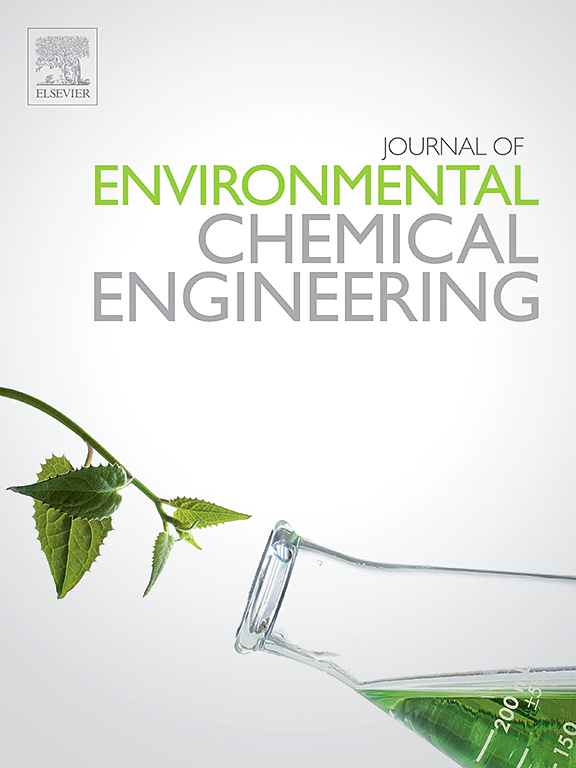通过硫空位调节g-C3N4/ ZnIn2S4的费米能级,实现载流子迁移途径转化,增强光催化莫西沙星降解活性
IF 7.4
2区 工程技术
Q1 ENGINEERING, CHEMICAL
引用次数: 0
摘要
调控载体在光催化剂中的迁移路径是提高光催化性能的有效策略。本研究提出了一种利用硫空位来调节ii型g-C3N4/ZnIn2S4 (CN/ZIS-Vp)异质结中载流子迁移途径的新方法。结合实验结果和密度泛函数理论分析,硫空位的引入增加了供体载流子浓度,提高了富空位的ZIS (ZIS- vr)的费米能级,导致CN/ZIS-Vr异质结的光生载流子迁移方向与cn /ZIS- vp相反,从而使异质结结构从ii型转变为s型。这增强了光生载流子的分离和迁移效率以及内部电场的强度。结果表明,该异质结对moxifloxacin (MOXI)的光催化降解效率为95.36 %,降解率为0.0416 min−1,是CN/ZIS-Vp体系的2.11倍。MOXI的降解产物对环境的危害较小。该工作为合理设计s型光催化剂以高效降解MOXI提供了有价值的见解。本文章由计算机程序翻译,如有差异,请以英文原文为准。
Achieving carrier migration pathway transformation to enhance photocatalytic moxifloxacin degradation activity by regulating the Fermi Level of g-C3N4/ ZnIn2S4 through sulfur vacancies
Regulating the carrier migration pathways in photocatalysts is an effective strategy to enhance their photocatalytic performance. In this study, a novel approach was proposed to modulate the carrier migration pathways in type-II g-C3N4/ZnIn2S4 (CN/ZIS-Vp) heterojunction by utilizing sulfur vacancies. Integrating findings from experiments and density functional theory analyses, the introduction of sulfur vacancies increased the donor carrier concentration and elevated the Fermi level of vacancy-rich ZIS (ZIS-Vr), leading to the opposite direction of photogenerated carrier migration in the CN/ZIS-Vr heterojunction as compared with that in the CN/ZIS-Vp, so that the introduction of sulfur vacancies transformed the heterojunction structure from type-II to S-scheme, which strengthened the separation and migration efficiency of photogenerated carriers as well as the intensity of internal electric field. As a result, the CN/ZIS-Vr heterojunction achieved a remarkable photocatalytic degradation efficiency of 95.36 % for moxifloxacin (MOXI), corresponding to a degradation rate of 0.0416 min−1, which was 2.11 times higher than that of the CN/ZIS-Vp system. The degradation products of MOXI have lower environmental hazards. This work offers valuable insights into the rational design of S-scheme photocatalysts for the efficient degradation of MOXI.
求助全文
通过发布文献求助,成功后即可免费获取论文全文。
去求助
来源期刊

Journal of Environmental Chemical Engineering
Environmental Science-Pollution
CiteScore
11.40
自引率
6.50%
发文量
2017
审稿时长
27 days
期刊介绍:
The Journal of Environmental Chemical Engineering (JECE) serves as a platform for the dissemination of original and innovative research focusing on the advancement of environmentally-friendly, sustainable technologies. JECE emphasizes the transition towards a carbon-neutral circular economy and a self-sufficient bio-based economy. Topics covered include soil, water, wastewater, and air decontamination; pollution monitoring, prevention, and control; advanced analytics, sensors, impact and risk assessment methodologies in environmental chemical engineering; resource recovery (water, nutrients, materials, energy); industrial ecology; valorization of waste streams; waste management (including e-waste); climate-water-energy-food nexus; novel materials for environmental, chemical, and energy applications; sustainability and environmental safety; water digitalization, water data science, and machine learning; process integration and intensification; recent developments in green chemistry for synthesis, catalysis, and energy; and original research on contaminants of emerging concern, persistent chemicals, and priority substances, including microplastics, nanoplastics, nanomaterials, micropollutants, antimicrobial resistance genes, and emerging pathogens (viruses, bacteria, parasites) of environmental significance.
 求助内容:
求助内容: 应助结果提醒方式:
应助结果提醒方式:


